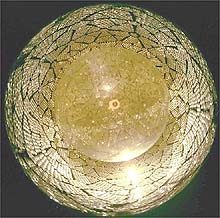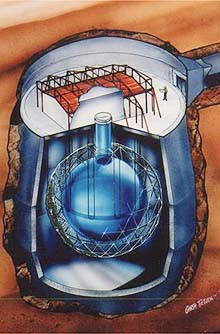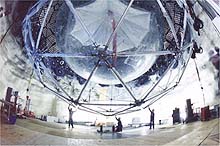|
If all the neutrinos reaching Earth from the Sun were of the
electron variety, then the neutrino rates measured by
Super-Kamiokande and Sudbury should match up. But Super- Kamiokande
detected more. Since the Sun produces only electron neutrinos — the
production of muon and tau neutrinos require higher-energy events,
like matter falling into black holes or an exploding star — that
means some of them must change into muon or tau neutrinos.
"It's the first direct evidence for the changing of solar
neutrinos from electron type to another type," Dr. Klein said. Most
physicists had considered neutrino morphing to be the most likely
explanation for the missing neutrinos.
Dr. Caldwell's theory was that the electron neutrinos were
changing into "sterile" neutrinos that did not interact with
ordinary matter. "It looks like they've done a very thorough job,"
he said. "It then is a real question if there is any room for a
sterile neutrino. I don't see much hope for it right now."
According to the equations of particle physics, for this
transformation of flavors to occur, at least one of the neutrino
types must possess a smidgeon of mass. Coupled with earlier
experimental results, the researchers conclude that each of the
three neutrino flavors weigh, at most, one-60,000th as much as an
electron.
But the universe is filled with more neutrinos than any other
known type of particle, and some physicists have wondered whether
the collective gravitation pull of neutrinos may be strong enough to
stop the outward expansion of the universe and pull it back into a
big crunch.
At the upper limit, the mass of neutrinos may be substantial,
perhaps as much as the rest of ordinary matter, but far short of the
amount needed to collapse the universe.
Most of the mass of the universe is believed to be in "dark
matter," a still unknown form of matter.
For particle physicists, the neutrino data is one more piece that
they will need to incorporate into a future unified theory of
physics that describes the behavior of all particles and forces. The
current standard model does not predict the masses of neutrinos, but
its equations are simpler if neutrinos have no mass.
Now scientists know the behavior of neutrinos is not simple.
Neutrinos are "very schizophrenic," Dr. Bahcall said. Still unknown,
for example, is whether the electron neutrinos are changing into
muon neutrinos or tau neutrinos or both.
"I expect to be up late at night trying to answer that question,"
Dr. Bahcall said. "It's pointing us in a way — in the right way, we
hope — to make a better theory, a more encompassing
theory."
| |


